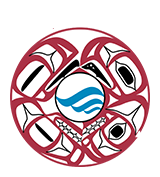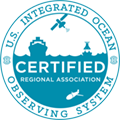Fisheries & Marine Life
Animal Tracking via Acoustic Telemetry:
As part of the IOOS Animal Telemetry Network efforts, in 2012-2013 NANOOS co-led a community needs assessment and data-access technology development project on animal acoustic telemetry data, featured on the Fall 2012 NANOOS Observer newsletter. While the project used Pacific NW data, it brought together not only reginal partners such as the NOAA Northwest Fisheries Center and the Hydra system, but also national, Canadian and Australian collaborators. Core project partners included IOOS, the Pacific Ocean Shelf Tracking Project (POST) which is no longer in operation, and the Ocean Tracking Network (OTN). The primary outcomes were the development of data exchange standards and best-practice data delivery systems that are now being implemented at a wider scale by OTN to provide access to their OTN Northeast Pacific data node, which includes POST data.
The demonstration systems deployed by NANOOS with POST/OTN data are:
- An ERDDAP server implementation for generalized data access and subsetting.
- A GeoServer implementation for geospatial (GIS) access.
Note that while the data available on these demonstration systems are real observations, they should not be used from these systems for any real-world application. To obtain the authoritative, quality-controlled and up-to-date data, please go to the OTN Northeast Pacific data node; links to that OTN node are also available from datasets in the ERDDAP system.
Puget Sound:
Measurements in Hood Canal are used to predict, observe, and inform management agencies and the public about low oxygen events and related fish kills.
In response to state declared "oyster emergency", a buoy was relocated closer to oyster hatcheries in Hood Canal to monitor water conditions (including acidity) related to hatchery failure.
Washington Shelf:
To support management by the Quinault Indian Nation Dept of Fisheries, a glider collects data from the Washington shelf to characterize upwelled water, detection of hypoxia, and biological blooms.
Sea surface current data are used to characterize the dispersal of Harmful Algal Blooms (HABs) to beaches supporting the recreational razor clam fishery.
Columbia River:
Data from the northern OR shelf and along the Columbia and Willamette Rivers support salmon ocean-survival biological opinions, including those related to hydropower management.
South Slough:
Water quality data are used to support decisions by commercial oyster growers and oyster restoration managers in Coos Bay.
Areas of Emphasis
Maritime Operations |
Coastal Hazards |
Fisheries & Marine Life |
Marine Ecosystems |
Weather & Climate |
Related Topics
Harmful Algal Blooms
Ocean Acidification
Coastal and Estuarine Hypoxia
Coastal & Marine Spatial Planning
Related NANOOS Products
Forecast Information and Data Products for Fishers
Information and data products oriented towards commercial and recreational albacore tuna fishing communities.
Puget Sound Networked Profiling Buoy
Data from a profiling buoy located at Point Wells (north of Seattle). The sensor package measures a depth profile of oceanographic variables every hour from the sea surface to the sea bed.
Puget Sound ORCA
Oceanic Remote Chemical Analyzer (ORCA) measures physical, chemical, and biological water characteristics in Hood Canal.
Water Quality Data for Shellfish Growers
Real-time Water Quality Data for Shellfish Growers. A pilot project between NANOOS and the National Estuarine Research Reserve System.
CMOP/NANOOS Phoebe Glider (Quinault) Transect
Research mission is to support sustained characterization of events and gradient regions in the Washington shelf, with focus on the Grays Harbor line, and help enhance models.
NANOOS members involved in this effort include:
Northwest Indian Fisheries Commission
Oregon Health and Science University
King County Dept. of Natural Resources and Park
NOAA Northwest Fisheries Science Center
NOAA Olympic Coast National Marine Sanctuary
Oregon Dept. of Fish and Wildlife
Washington Dept. of Fish and Wildlife
Hood Canal Salmon Enhancement Group
Pacific Northwest Salmon Center
Columbia River Crab Fisherman's Association
| National Observing System Partners Alliance for Coastal Technologies (ACT) Southeastern Universities Research Association (SURA) Integrated Ocean Observing System IOOS | |||||||

